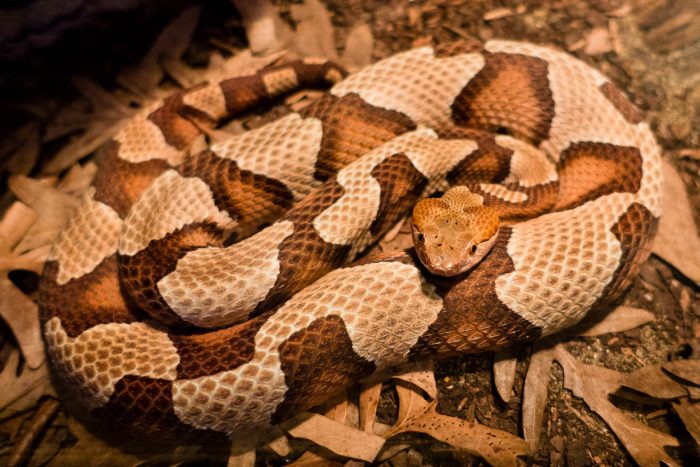Copperhead
Agkistrodon contortrix
The copperhead snake is one of only a few venomous snakes found in the Chesapeake Bay watershed, although it is rarely lethal to humans.
This section shows one large critter image at a time. Use the thumbnails that follow to select a specific image to display here.

This gallery contains a grid of small thumbnails. Selecting a thumbnail will change the main image in the preceding section.
Appearance
The copperhead has a broad, unmarked, copper-colored head and a reddish-tan colored body. It has hourglass-shaped darker marks on its back. Its underside is a pinkish color. Adult copperheads can reach about three feet in length. The copperhead is a “pit-viper,” which refers to the heat-sensing pit located on its head between its eye and nostrils.
Feeding
Copperheads are carnivorous, eating mainly mice but also feeding on birds, snakes, amphibians and insects. They are known as ambush predators. Copperheads will hide and wait in one spot for suitable prey to approach before attacking. The heat-sensing pit on their face helps in finding prey. Copperheads will inject venom to capture their prey, making it easier to swallow whole.
Predators
Owls and hawks are the copperhead’s main predators. Opossums, raccoons and other snakes may also prey on copperheads.
Reproduction and life cycle
Mating occurs in late spring to early summer, and can also occur in the fall. Copperheads are ovoviviparous, making fertilized eggs develop inside the female, nourished by a yolk, and young are born alive. Gestation lasts between three and nine months, depending on whether the snake undergoes hibernation before giving birth.
Between two and ten young are in a single brood, depending on the female’s size. Young reach sexual maturity after four years. Copperheads hibernate during the winter in dens with other snakes, some of different species. They live up to 18 years, on average.
Did you know?
- Young copperheads have yellow-tipped tails, which they use to attract small prey.
- Copperheads bite more people each year than any other snake species in the United States. Even though copperheads are venomous, they are normally calm snakes that only bite if stepped on or otherwise threatened. If you see a copperhead, leave it alone! Allow it to continue on its way, undisturbed.
- Unlike many other viper species, copperheads do not try to make a quick getaway when they sense danger. Instead, they stop moving and wait for the danger to pass. Their brown, tan and rust coloring can make these motionless copperheads difficult to spot when lying on leaves or soil. Always look before you step when hiking in areas where copperheads are common.
- Like many snakes, copperheads are diurnal in the spring and fall, but become nocturnal during the summer.
Sources and additional information
- Field Guide to Maryland’s Snakes: Northern Copperhead and Intergrade – Maryland Department of Natural Resources
- Venomous Snakes in Maryland – Maryland Department of Natural Resources
- Copperhead Snake – The Virtual Nature Trail at Penn State New Kensington
- Animal Diversity Web: Agkistrodon contortrix – University of Michigan Museum of Zoology
- Northern Copperhead – Smithsonian National Zoological Park
- Agkistrodon contortrix – Encyclopedia of Life
